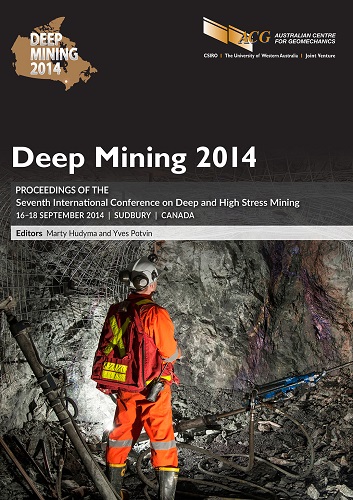4D data management and modelling in the assessment of deep underground mining hazard

|
Authors: McGaughey, WJ |
DOI https://doi.org/10.36487/ACG_rep/1410_04_McGaughey
Cite As:
McGaughey, WJ 2014, '4D data management and modelling in the assessment of deep underground mining hazard', in M Hudyma & Y Potvin (eds), Deep Mining 2014: Proceedings of the Seventh International Conference on Deep and High Stress Mining, Australian Centre for Geomechanics, Perth, pp. 93-106, https://doi.org/10.36487/ACG_rep/1410_04_McGaughey
Abstract:
A framework is presented for quantitative assessment of deep underground mining hazard. It is general in the sense that it may be applied to many types of underground geotechnical and mining challenges. We present a case study illustrating the methodology from the former Xstrata Craig Mine in Sudbury, now closed, which experienced significant fault-slip rockbursting while in operation. The general approach described is statistical, based on data from a site history that quantitatively assesses correlations between falls of ground and various objectively measurable criteria. The hazard criteria are in the categories of geology, rock quality, stress, seismicity, development geometry and production sequencing, blasting, and various geotechnical monitoring systems. The criteria are modelled throughout the mine area of interest and quantitatively combined into an overall hazard index using weights established by the statistical correlation. In the Craig Mine example, several criteria in each of the major categories were modelled and combined to yield independent estimations of hazard in the ore zone and footwall. The statistical analysis clearly showed that individual hazard criteria could be quantitatively correlated to the experience of fault-slip rockbursting, with significantly different results in the ore zone and footwall. Modelling the hazard criteria can be challenging, not least because many of the key criteria, and thus the resulting models, are four-dimensional. In practice the 4D nature of the problem is handled by time-stepping a 3D model. The modelling requires interpretational judgement in terms of how data such as structure, rock quality, and seismicity, often located far into the rock mass away from development, manifest hazard on the mine infrastructure where it is experienced. A 4D data management system is required to make the modelling efficient, particularly if it is set up to respond to real time data. Using the Craig Mine case study, we review the key design elements of such a 4D data management foundation, a 4D modelling system, and the 4D deep underground mining hazard assessment framework resulting from their integration.
References:
Agterberg, FP, Bonham-Carter, GF & Wright, DF 1990, ‘Statistical pattern integration for mineral exploration’, in G Gaal & DF Merriam (eds), Computer Applications in Resource Estimation: Prediction and Assessment for Metals and Petroleum, Pergamon Press, London.
Agterberg, FP & Cheng, Q 2002, ‘Conditional independence test for Weights-of-Evidence modelling’, Natural Resources Research, vol. 11, no. 4, pp. 249-255.
Apel M & Böhme, M 2006, ‘Predictive 3D mineral potential modelling’, Proceedings of the 26th GOCAD Research Consortium Meeting, École Nationale Supérieure de Géologie, Nancy.
Bonham-Carter, GF 1994, Geographic Information Systems for Geoscientists: Modelling with GIS, Pergamon Press, London.
Bonham-Carter, GF 1997, ‘GIS methods for integrating exploration data sets’, in AG Gubins (ed.), Proceedings of Exploration 97: Fourth Decennial Conference on Mineral Exploration, Prospectors and Developers Associaton, Toronto, pp. 59-64.
Bonham-Carter, GF, Agterberg, FP & Wright, DF 1989, ‘Weights of evidence modelling: a new approach to mapping mineral potential’, in FP Agterberg & GF Bonham-Carter (eds), Statistical applications in the earth sciences, issue 89-9, Geological Survey of Canada, Ottawa.
Caumon, G, Ortiz, J & Rabeau, O 2006, ‘A comparative study of three data-driven mineral potential mapping techniques’, in E Pirard, A Dassargues & H-S Havenith (eds), Proceedings of the XIth International Congress of the International Association for Mathematical Geology, International Association for Mathematical Geology.
Lopez-Pacheco, A 2013, ‘Rio Tinto creates integrated data management system for all its cave mines’, CIM Bulletin, vol. 8, no. 4, pp. 34-36.
McGaughey, WJ 2006, ‘The Common Earth Model: A Revolution in Mineral Exploration Data Integration’, in JR Harris (ed.), GIS for the Earth Sciences, special publication 44, Geological Association of Canada, St. John’s.
Mol, M, van As, A, Tosen, R & McGaughey, WJ 2012, ‘The design and development of an integrated cave management system’, Proceedings of the 6th International Conference & Exhibition on Mass Mining: MassMin 2012, Canadian Institute of Mining, Metallurgy and Petroleum, Westmount.
Thiart, C, Bonham-Carter, GF, Agterberg, FP, Cheng, Q & Panahi, A 2006, ‘An application of the new omnibus test for conditional independence in Weights-of-Evidence modelling’, in JR Harris (ed.), GIS for the Earth Sciences, special publication 44, Geological Association of Canada, St. John’s.
© Copyright 2025, Australian Centre for Geomechanics (ACG), The University of Western Australia. All rights reserved.
View copyright/legal information
Please direct any queries or error reports to repository-acg@uwa.edu.au
View copyright/legal information
Please direct any queries or error reports to repository-acg@uwa.edu.au